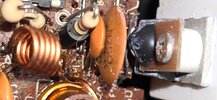Hello,
I have a GALAXY SATURN that was working fine until the finals went down.
I am getting a few watts out so I am asuming the driver is good.
Can anyone tell me what finals are installed? Also there are what look like caps of sorts that are piggy back on the finals.
Thats why I cannot tell what they are.
What are these for, as I have never seen these (Caps) as I am very old school and probably older then most here! There are two finals.
Did Galaxy install two Bipolars back then or would these be Mosfet?
What ever they are, can they still be purchased? Can someone please give me the scoop on where to go from here, or the 411 !!!
I can replace them and I can bios them, I just need to know what to buy and where?
Thank you all for your insight, your experience, and for your valuable information!
RF Krazy
I have a GALAXY SATURN that was working fine until the finals went down.
I am getting a few watts out so I am asuming the driver is good.
Can anyone tell me what finals are installed? Also there are what look like caps of sorts that are piggy back on the finals.
Thats why I cannot tell what they are.
What are these for, as I have never seen these (Caps) as I am very old school and probably older then most here! There are two finals.
Did Galaxy install two Bipolars back then or would these be Mosfet?
What ever they are, can they still be purchased? Can someone please give me the scoop on where to go from here, or the 411 !!!
I can replace them and I can bios them, I just need to know what to buy and where?
Thank you all for your insight, your experience, and for your valuable information!
RF Krazy



